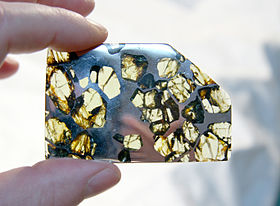
Pallasite

The pallasites are a class of stony–iron meteorite. The pallasites are a class of stony–iron meteorite. It consists of centimeter-sized olivine crystals of peridot quality in an iron-nickel matrix. Coarser metal areas develop Widmanstätten patterns upon etching. Minor constituents are schreibersite, troilite, chromite, pyroxenes, and phosphates (whitlockite, stanfieldite, farringtonite, and merrillite). Using the oxygen isotopic composition, meteoric iron composition and silicate composition pallasites are divided into 4 subgroups: Pallasites were once thought to originate at the core-mantle boundary of differentiated asteroids that were subsequently shattered through impacts. An alternative recent hypothesis is that they are impact-generated mixtures of core and mantle materials. A common error is to associate their name with the asteroid 2 Pallas but their actual name is after the German naturalist Peter Pallas (1741–1811), who studied in 1772 a specimen found earlier near Krasnoyarsk in the mountains of Siberia that had a mass of 680 kilograms (1,500 lb). The Krasnoyarsk mass described by Pallas in 1776 was one of the examples used by E.F.F. Chladni in the 1790s to demonstrate the reality of meteorite falls on the Earth, which were at his time considered by most scientists as fairytales. This rock mass was dissimilar to all rocks or ores found in this area (and the large piece could not have been accidentally transported to the find site), but its content of native metal was similar to other finds known from completely different areas. Pallasites are a rare type of meteorite. Only 61 are known to date, including 10 from Antarctica, with four being observed falls. The following four falls are in chronological order:
